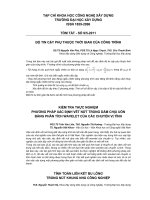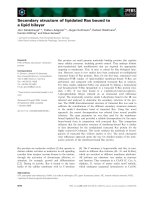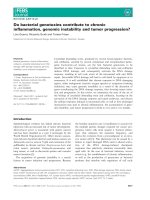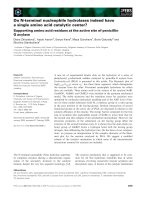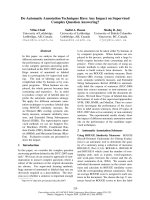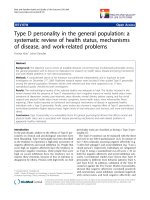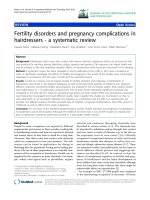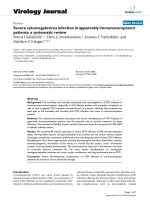báo cáo khoa học: " Do self- reported intentions predict clinicians'''' behaviour: a systematic review" ppt
Bạn đang xem bản rút gọn của tài liệu. Xem và tải ngay bản đầy đủ của tài liệu tại đây (308.63 KB, 10 trang )
BioMed Central
Page 1 of 10
(page number not for citation purposes)
Implementation Science
Open Access
Systematic Review
Do self- reported intentions predict clinicians' behaviour: a
systematic review
Martin P Eccles*
1
, Susan Hrisos
1
, Jill Francis
2
, Eileen F Kaner
1
,
Heather O Dickinson
1
, Fiona Beyer
1
and Marie Johnston
3
Address:
1
Centre for Health Services Research, University of Newcastle upon Tyne, 21 Claremont Place, Newcastle upon Tyne, NE2 4AA, UK,
2
Health Services Research Unit, University of Aberdeen, Health Sciences Building, Foresterhill, Aberdeen AB25 2ZD, UK and
3
Department of
Psychology, University of Aberdeen, Health Sciences Building, Foresterhill, Aberdeen AB25 2ZD, UK
Email: Martin P Eccles* - ; Susan Hrisos - ; Jill Francis - ;
Eileen F Kaner - ; Heather O Dickinson - ; Fiona Beyer - ;
Marie Johnston -
* Corresponding author
Abstract
Background: Implementation research is the scientific study of methods to promote the systematic uptake of
clinical research findings into routine clinical practice. Several interventions have been shown to be effective in
changing health care professionals' behaviour, but heterogeneity within interventions, targeted behaviours, and
study settings make generalisation difficult. Therefore, it is necessary to identify the 'active ingredients' in
professional behaviour change strategies. Theories of human behaviour that feature an individual's "intention" to
do something as the most immediate predictor of their behaviour have proved to be useful in non-clinical
populations. As clinical practice is a form of human behaviour such theories may offer a basis for developing a
scientific rationale for the choice of intervention to use in the implementation of new practice. The aim of this
review was to explore the relationship between intention and behaviour in clinicians and how this compares to
the intention-behaviour relationship in studies of non-clinicians.
Methods: We searched: PsycINFO, MEDLINE, EMBASE, CINAHL, Cochrane Central Register of Controlled
Trials, Science/Social science citation index, Current contents (social & behavioural med/clinical med), ISI
conference proceedings, and Index to Theses. The reference lists of all included papers were checked manually.
Studies were eligible for inclusion if they had: examined a clinical behaviour within a clinical context, included
measures of both intention and behaviour, measured behaviour after intention, and explored this relationship
quantitatively. All titles and abstracts retrieved by electronic searching were screened independently by two
reviewers, with disagreements resolved by discussion.
Discussion: Ten studies were found that examined the relationship between intention and clinical behaviours in
1623 health professionals. The proportion of variance in behaviour explained by intention was of a similar
magnitude to that found in the literature relating to non-health professionals. This was more consistently the case
for studies in which intention-behaviour correspondence was good and behaviour was self-reported. Though firm
conclusions are limited by a smaller literature, our findings are consistent with that of the non-health professional
literature. This review, viewed in the context of the larger populations of studies, provides encouragement for
the contention that there is a predictable relationship between the intentions of a health professional and their
subsequent behaviour. However, there remain significant methodological challenges.
Published: 21 November 2006
Implementation Science 2006, 1:28 doi:10.1186/1748-5908-1-28
Received: 09 May 2006
Accepted: 21 November 2006
This article is available from: />© 2006 Eccles et al; licensee BioMed Central Ltd.
This is an Open Access article distributed under the terms of the Creative Commons Attribution License ( />),
which permits unrestricted use, distribution, and reproduction in any medium, provided the original work is properly cited.
Implementation Science 2006, 1:28 />Page 2 of 10
(page number not for citation purposes)
Background
Implementation research is the scientific study of meth-
ods to promote the systematic uptake of clinical research
findings into routine clinical practice, and hence to reduce
inappropriate care. It includes the study of influences on
healthcare professionals' behaviour, and methods to ena-
ble them to use research findings more effectively. Over
the last decade a considerable body of such research has
been both published and reviewed [1,2]. This research
demonstrates that several (variously complex) interven-
tions can be effective in changing health care profession-
als' behaviour. However, these studies have substantial
heterogeneity within interventions, targeted behaviours,
and study settings that render generalisability problematic
[3].
In order to optimise the number of costly and time con-
suming future trials that need to be conducted – and to
enhance their generalisability, it is necessary to identify
the 'active ingredients' in professional behaviour change
strategies. Interventions could be effective at changing
behaviour for two reasons: they may contain components
that are always effective in changing any behaviour, or
they may contain components that overcome specific bar-
riers encountered in relation to a particular behaviour.
Hence, two approaches are necessary to identify the 'active
ingredients' in the complex interventions of implementa-
tion trials: 1) Develop an understanding of the factors
underlying professional behaviour in order to identify
what sorts of processes should be targeted by interven-
tions (process modelling) [4], and 2) Develop an under-
standing of how the interventions work and can be
optimised (intervention modelling) [5].
In intervention modelling, key elements of an interven-
tion are manipulated in a manner that simulates a real sit-
uation as much as possible, and interim endpoints are
measured rather than changes in professional behaviour
or healthcare outcome. A typical interim endpoint is a
stated intention to behave in a particular way. Intention
has been defined as "indications of how hard people are
willing to try, of how much effort they are planning to
exert, in order to perform a behaviour" [6] (see page 181).
Compared to large scale trials, modelling experiments
have two potential advantages – smaller size and shorter
timescales – whilst still offering experimental control.
Although proof of concept work has demonstrated the
feasibility of such studies [5], a prerequisite of this
method is a predictable link between the interim end-
points and changes in actual professional behaviour. For
the method to be valid, interim endpoints (e.g. measures
of intention) must be predictive of real world outcomes.
This is the case for behavioural intention in non-clinical
populations as demonstrated by reviews of both observa-
tional and experimental studies. Godin and Kok [7]
reported averaged correlations between intention and dif-
ferent health-related behaviours ranging from 0.35 to
0.56 (i.e. intention was accounting for between 12% and
31% of the variance in behaviour). Armitage and Connor
[8], using 63 independent studies reporting prospectively
measured behavioural data, reported that the Theory of
Planned Behaviour (TPB) variables that directly influence
behaviour (intention and perceived behavioural control)
accounted for a similar proportion of the variance in
behaviour. When behavioural measures were self-
reported, the TPB accounted for more of the variance in
behaviour than when behaviour measures were objective
or observed. A meta-analysis of 10 meta-analyses by
Sheeran [9] reported that intention accounted for almost
one-third of the variance in behaviour. Finally, Webb and
Sheeran [10] reviewed experimental studies to relate
change in intention to change in behaviour. From a meta-
analysis of 47 experimental tests of the intention-behav-
iour relationship, they concluded that a "medium-to-
large" change in intention leads to a "small-to-medium"
change in behaviour. None of these reviews [7-10] specif-
ically identified studies of healthcare professionals and
clinical behaviours.
These reviews demonstrate that there is a reliable, but not
a perfect, relationship between stated intention and
behaviour. Considerable research efforts have been
directed to addressing the 'intention-behaviour gap' and
two approaches have been proposed. One addresses the
variability of the link by focusing on moderators of the
intention-behaviour relationship, such as intention cer-
tainty and attitudinal versus normative control [11].
According to this approach, it is possible to predict which
individuals will enact their intentions (e.g. those whose
intentions are attitudinally controlled). A second
approach focuses on mediators of the intention-behav-
iour relationship, or processes that might be regarded as
'post-intentional,' such as implementation intentions
[12], action plans and coping plans [13]. This approach
identifies processes that assist individuals to enact their
intentions, thereby minimising the size of the intention-
behaviour gap.
It has been argued [14] that the intentions and behaviour
of clinicians are influenced by measurable psychological
variables (e.g. attitudes) in the same way as the intentions
and behaviour of any individual. However, most psycho-
logical models of behaviour are predicated on the basis of
perceived consequences of a behaviour being experienced
by the actor (e.g. If I give up smoking, I will improve my phys-
ical fitness). For clinicians, the perceived (or actual) conse-
quences of their clinical behaviours are often (though not
always) experienced by another person (e.g. If I lower my
patient's blood pressure, she will have a reduced risk of prema-
ture mortality). Furthermore, clinical behaviour is con-
Implementation Science 2006, 1:28 />Page 3 of 10
(page number not for citation purposes)
strained by a number of factors, such as imperatives
dictated by a professional role, legal responsibilities, and
principles of clinical governance. Although in a theoreti-
cal context these may be seen as control factors that influ-
ence behaviour together with intentions, some of these
factors may not be articulated by clinicians. As they always
form part of the context of any clinical behaviour, they
may be implicit but powerful influences on intentions
and behaviour, or the relationship between them. There-
fore, it is important to explore the intention-behaviour
relationship relating to clinical behaviour.
This review addresses the following two questions: 1)
What is the nature of the relationship between measures
of intention and clinical behaviours in clinicians? and 2)
How does this compare to the intention-behaviour rela-
tionship in studies of non-clinicians?
Methods
Criteria for studies included in the review
We included any study that examined clinical behaviour
(behaviour enacted by a clinician (doctors, nurses, and
allied health professionals) within a clinical context with
respect to a patient or their care. We also included meas-
ures of both intention and behaviour and explored this
relationship quantitatively, and measured behaviour after
intention had been measured.
Measures of intention and behaviour
As clinical behaviour is often enacted in contexts with a
high focus on patient privacy, confidentiality, and matters
of personal sensitivity, it may not always be feasible to
measure clinical behaviour through direct independent
observation. Where direct measurement is not possible,
studies may use alternative or "reported" measures of the
behaviour under investigation. The following criteria were
used to define acceptable measures of intentions,
observed behaviour, and reported behaviour for studies
included in this review.
Two methods of measuring intention were included:
1. Strength of intention, where clinicians are asked to
indicate (e.g., on a 7-point scale) how strongly they agree
or disagree with a specific intention statement regarding
the target behaviour. Intention could also be characterised
as 'willingness' or 'readiness.'
2. Percentage estimates, where clinicians are asked to indi-
cate for what proportion of patients with a particular con-
dition they intend to perform the target behaviour.
Four measures of behaviour were included:
1. Self-reported behaviour, where, for example, a clinician
completes a diary or questionnaire, recording how many
patients with type 2 diabetes were seen that day or that
week – and how many of the patient's feet were inspected.
Self-report of behaviour must be reported retrospectively,
i.e. after the behaviour has been enacted, and must be
measured after intention has been measured.
2. Observed behaviour, including directly observed, audio
or video-taped behaviour.
3. Patient-reports of clinician behaviour, where, for exam-
ple, a patient is asked to report which prescribed medica-
tions are being taken as a measure of the clinician's
prescribing behaviour.
4. Documented behaviour, where, for example, the order-
ing of a radiology test is automatically recorded as part of
the ordering process, or a blood pressure reading is
recorded in a patient's case notes by the clinician.
Search strategy
The following databases were searched: PsycINFO (1840-
Aug 2004), MEDLINE (1966-Aug wk 3 2004), EMBASE
(1980-Aug wk 34), CINAHL (1982-Aug wk 3 2004),
Cochrane Central Register of Controlled Trials (2004
issue 2), Science/Social science citation index (1970-Aug
2004), Current contents (social & behavioural med/clini-
cal med) (1998-Aug 2004), ISI conference proceedings
(1990-Aug 2004), and Index to Theses (1716-Aug 2004).
The search terms for intention, behaviour, health profes-
sionals, and scenarios are shown in Table 1. The search
domains were combined as follows: (Intention) AND
(Behaviour) AND (Health professionals), (Intention-
behaviour) AND (Health professionals), (Behaviour)
AND (Outcomes) AND (Health professionals). The refer-
ence lists of all included papers were checked manually.
Review methods
All titles and abstracts retrieved by electronic searching
were downloaded to a Reference Management database;
duplicates were removed and the remaining references
were screened independently by two reviewers, and those
studies which did not meet the inclusion criteria were
excluded. Where it was not possible to exclude articles
based on title and abstract, full text versions were
obtained and their eligibility was assessed by two review-
ers. Full text versions of all potentially relevant articles
identified from the reference lists of included articles were
obtained. The eligibility of each full text article was
assessed independently by two reviewers. Disagreements
were resolved by discussion or were adjudicated by a third
reviewer.
Implementation Science 2006, 1:28 />Page 4 of 10
(page number not for citation purposes)
Internal validity was independently assessed by two
reviewers on the basis of the level of correspondence
between the wording of the intention item and the behav-
iour as measured (graded as good, poor or unclear), and
internal consistency of multiple intention items as meas-
ured by Cronbach's alpha [15]. External validity was
assessed on the basis of whether the target population was
local, regional or national; whether the target population
was sampled or whether the entire population was
approached; and if the population was sampled, whether
it was a valid random (or systematic) sample. Susceptibil-
ity to bias was assessed on the basis of the percentage of
participants approached for whom the relationship
between intention and behaviour was analysed.
For each study, we abstracted, where possible, the Pearson
correlation coefficient (r) between the measure of inten-
tion and the measure of behaviour (equivalent to the
standardised beta coefficient) and its standard error. If
this was not available and structural equation modelling
had been performed, we abstracted the structural coeffi-
cient corresponding to the direct relationship between
intention and behaviour and its standard error. If neither
a Pearson correlation coefficient nor a structural coeffi-
cient was available and multiple regression had been per-
formed, we abstracted the partial correlation coefficient
relating the intention to behaviour and its standard error,
as well as the model R
2
summarizing the proportion of the
variance between participants that could be explained by
the variables in the regression.
Results
Description of the studies
The initial searches identified 5260 studies (Fig 1). Of 82
papers retrieved for full text review, 10 fulfilled the eligi-
bility criteria and their data were extracted [16-25].
Reviewers agreed on the eligibility of all the included stud-
ies. Of the 72 studies excluded at full text review, 8 (11%)
Table 1: Keyword combinations for four domains, combined for the database search
Intention (Intention or intend*) Behaviour near behavio?r* Health professionals
Thesaurus heading: Thesaurus headings: Thesaurus headings:
INTENTION • BEHAVIOR • HEALTH PERSONNEL
• CHOICE BEHAVIOR • ATTITUDE OF HEALTH PERSONNEL
• PLANNED BEHAVIOR • CLINICIANS
• Intend* or intention*• Behavio?r* Clinician*
• Inclin* or disinclin*• Clinician performance* Counse?lor*
• (Actor or abstainer) near behavi*r* Dentist*
Doctor*
Family practition*
General practition*
GP*/FP*
Gyn?ecologist*
H?ematologist*
Health professional*
Internist*
Neurologist*
Nurse*
Obstetrician*
Occupational therapist*
Optometrist*
OT*
P?ediatrician*
Paramedic*
Pharmacist*
Physician*
Physiotherapist*
Primary care
Psychiatrist*
Psychologist*
Radiologist*
Social worker*
Surgeon*/surgery
Therapist*
Example thesaurus headings are given for the PsycINFO database and were adjusted and exploded as appropriate for other databases.
Implementation Science 2006, 1:28 />Page 5 of 10
(page number not for citation purposes)
were excluded following reconciliation. [A list of studies
excluded at this point is available from the authors.] The
eligible studies approached a total of 3777 health care
professionals, and data from 1623 (43%) of these were
analysed. The characteristics of these studies are presented
in Table 2, and further detail is presented in Additional
file 1.
Study design
All studies used questionnaire survey methods to elicit
intention, and all study designs were non-experimental.
Participating healthcare professionals
The number of participants approached in each study
ranged from 39 to 2,087 (median 188). In six studies [18-
20,22,23,25] the participants were nurses, in three studies
they were doctors [16,21,24], and in the one remaining
study they were pharmacists [17].
Clinical behaviours
The studies covered five types of clinical behaviour: hand
hygiene behaviours (e.g., hand washing) [18,20], patient
education [16,19,22], clinical record-keeping [23,25],
drug choice (prescription) [21,24], and provision of phar-
maceutical care [17].
Theoretical framework used
The studies reported using mainly the Theory of Reasoned
Action (TRA, [26]) [16,19,21-25] and the Theory of
Planned Behaviour (TPB, [6]) [16,18-20]. Other frame-
works used were Triandis' Theory of Interpersonal Behav-
iour [27,18] and the "theory of goal-orientated
behaviours" [28], with the inclusion of perceived behav-
iour control [17].
Measurement of intention
Six studies used multiple-item intention measures [17-
20,22,23], and four studies used single-item intention
measures [16,21,24,25], two of which asked the same
item for each of a range of drugs [21,24]. The response for-
mat for nine studies was a 7-point scale, scored 1–7
[17,20,22,23,25] or scored -3 to +3 [18,19,21,24]. The
response format for one study was an estimated percent-
age, expressed in deciles [16].
Measurement of behaviour
One study used patient-report of behaviour [22], four
studies used self-report [16-19] one used observation
[21], one study used both self-report and observation[20],
and three studies used documented data [23-25].
Measurement of intention-behaviour relationship
We were able to abstract the correlation between the
measures of intention and behaviour for all studies except
Bernaix [22]. Only three studies [17,23,24] reported the
standard error of this correlation or statistics from which
it could be estimated, so it was not possible to aggregate
the study results in a meta-analysis.
Quality
The reviewers agreed on the correspondence between the
intention and behaviour measures for five of the studies,
with correspondence ratings for the remaining five agreed
upon following reconciliation. Overall 5/10 studies were
judged to have good correspondence between the inten-
tion and behaviour measures [16-19,25]. Correlations
between intention and behaviour ranged from 0.0 to 0.40
when correspondence was "Good," from 0.0 to 0.18 when
correspondence was "Unclear," and from 0.07 to 0.27
when correspondence was "Poor."
In 5 of 6 studies where multiple intention items were
combined to produce a composite measure of intention
internal consistency was acceptable; Cronbach's alphas
for measures of intention ranged from 0.74 to 0.93 in four
studies [18-20,22], and a correlation co-efficient of 0.66
was reported in one of two studies using two intentions
items [23]. No psychometrics were presented for the
intention measure used in the remaining study [17].
The psychometric properties presented for four studies
using observed behaviour [20], patient reported behav-
iour [22] and recorded behaviour [23,25] were acceptable;
internal consistency ranged from 0.71 to 0.95 for multiple
item instruments combined to produce summary scores
[22,23], and inter-rater reliability ranged from 0.76 to
0.98 for multiple [20,25] and single-raters [23]. The pro-
portion of participants for whom the relationship
between intention and behaviour was analysed ranged
from 25% to 94% (median 54%). The one study that used
Identification of included referencesFigure 1
Identification of included references.
Potentially relevant references
identified and screened
n = 5260
References retrieved for more
detailed evaluation
n = 82
References excluded at paper
screening stage
n = 72
References excluded at
electronic screening stage
n = 5178
Number of references meetin
g
inclusion criteria
n = 10
Implementation Science 2006, 1:28 />Page 6 of 10
(page number not for citation purposes)
Table 2: Summary of included study characteristics and results
Study 1. Type of
participants
2. Target
population
3. Sampling
strategy
Participants
approached and
analysed
1. Theoretical
framework
2. Target behaviour
Measure of
intention
Measure of behaviour Int-Bev
corr.
Outcome
N n % Description Psy Description Psy Meth beta (SE) p R
2
Millstein
16
1. Primary care
physicians
2. California, USA
3. Stratified random
sample from AMA
Masterfile
2087 765 (37%) 1. TRA, TPB
2. Patient education
% patients
they
intended to
educate
NA % patients they
educated
NA SR Good TRA:
TRB:
0.56
a
0.49
a
< 0.0001
< 0.0001
0.37
b
0.40
b
Farris
17
1. Community
pharmacists
2. All practising in
Alberta, Canada
3. Random sample
320 182 (57%) 1. "Theory of goal-oriented
behaviour"; included
perceived behavioural
control
2. Provision of
pharmatceutical care
activities
2 items, 7
point scale
* 20 items, No. of
care activities
provided
NA SR Good 0.52
c
(0.11) < 0.001 -
Godin
18
1. Nurses
2. One regional
hospital, Canada
3. All approached
238 105 (44%) 1. TPB; TIB
2. Adherence to universal
precautions for
venepuncture
4 items, 7-
point scale
0.82
d
No. of times
adhered to
universal
precautions for
last 10
venepunctures
performed
NA SR Good 0.37 0.001 0.25
Hoppe
19
1. Primary care
nurses
2. 4 districts, UK
3. Random sample of
GP practices, one
nurse recruited from
each practice
260 132 (51%) 1. TRA, TPB
2. Patient education
5 items, 7
point scale
0.91
d
1 item, 7 point
scale
NA SR Good 0.56 < 0.001 0.31
O'Boyle
20
1. Nurses
2. 4 hospitals, USA
3. All approached
474 120 (25%) 1. TPB
2. Adherence to hand
hygiene regulations
5 items, 7-
point scale
0.74
d
% times practised
hand hygiene
0.94 to 0.98
f
SR
Ob
Unclear
Unclear
0.39
0.09
< 0.01
> 0.05
0.15
0.01
Lambert
21
1. Primary care
physicians
2. 5 clinics in one
HMO, USA
3. All approached
39 19 (49%) 1. TRA
2. Antibiotic preference
7-point scale
for each of 7
drugs
N/A No. of
prescriptions for
each drug as % of
prescriptions for
all 7 drugs
NA Ob Unclear -0.42 to 0.33 All n.s. 0.0 to 0.18
Implementation Science 2006, 1:28 />Page 7 of 10
(page number not for citation purposes)
Bernaix
22
1. Hospital nurses
2. 2 hospitals, USA
3. Sampled –
sampling strategy not
reported
52 49 (94%) 1. TRA
2. Provision of maternal
support
3 items, 7
point scale
0.93
d
46 items, 5 point
scale
0.91 to 0.95
g
PR Unclear * n.s. *
Renfroe
23
1. Hospital nurses
2. 3 hospitals, USA
3. All approached
138 108 (78%) 1. TRA
2. Documentation
2 items, 7
point scale, %
patients likely
to document
0.66
e
20 item checklist,
No. of items
documented
0.71
g
0.84
h
D Poor 0.41 (0.14) 0.003 0.15
Harrell
24
1. Primary care
physicians
2. 11 metropolitan
areas, eastern USA
3. Sampled from
existing physician
panel – sampling
strategy not
reported
104 93 (89%) 1. TRA
2. Drug preference
7-point scale
for each of 5
drugs
N/A Most frequently
prescribed drug
NA D Poor 0.27 to 0.52 0.015 to 0.001 0.07 to 0.27
Quinn
25
1. Nurses
2. General medical
and surgical wards of
one hospital, USA
3. All working on a
specific day
65 50 (77%) 1. TRA
2. Documentation of
teaching
1 item, 7
point scale
N/A No. of patients
with
documentation of
teaching/No. of
patients assigned
0.76
f
D Good R1:
R2:
0.08
0.02
> 0.05
> 0.05
0.01
0.00
N = Number of participants approached; n = Number of participants analysed; % = Percentage of participants approached who were analysed; Psy = Psychometrics;
Meth = Method of ascertainment of behaviour; Int-Bev Corr = Correspondance between measures of intention and behaviour
* = Not reported; N/A = Not applicable; n.s. = non-significant; SR = Self report; Ob = Observed; PR = Patient report; D = Documented
a Adjusted beta coefficient from multiple regression
b R
2
for multiple regression model
c Path coefficient from structural equation modelling
d Cronbach's alpha
e Correlation coefficient
f Inter-rater reliability
g Internal consistency
h Intra-class correlation coefficient
Table 2: Summary of included study characteristics and results (Continued)
Implementation Science 2006, 1:28 />Page 8 of 10
(page number not for citation purposes)
patient-reported behaviour based this on observations by
87% of the observers approached [22].
In terms of external validity, four studies considered
regional populations [16,17,19,24]; all other studies con-
sidered local populations such as physicians in 5 clinics in
one HMO [21], and nurses in one [18], two [22], three
[23] or four [20] hospitals. Five studies approached all
participants in their target populations [18,20,21,23,25].
Participants in the remaining five studies were sampled –
three studies used random selection [16,17,19] and two
did not specify their sampling strategy [22,24].
Relationship between intention and behaviour
The study results are summarised in Table 2 and Addi-
tional file 2.
In four of the five studies where a self-reported measure of
behaviour was used, the measure of intention corre-
sponded well to the measures of behaviour. All self-report
studies, including the one where correspondence was
unclear, found a statistically significant correlation
between intention and behaviour and R
2
ranged from
0.15 to 0.4 [16-20].
In four of the five studies where behaviour was observed,
recorded or traceable, the correspondence of the intention
and behaviour measures was rated as poor or unclear. Two
studies reported correlation coefficients describing the
relationship between intention and behaviour for pre-
scribing each of several drugs [21,24]. The estimated cor-
relation between intention and observed, recorded or
traceable behaviour ranged from -0.42 to 0.52 (median
0.14) [20,21,23-25]; one study of documentation [23]
and one study of drug preference [24] found this relation-
ship to be statistically significant.
Some of the studies may have been too small to find a sta-
tistically significant relationship between intention and
behaviour, even if such a relationship was present in the
population studied. The three smallest studies, [21,22,25]
each with an analysed sample of 50 participants or fewer,
failed to show a statistically significant relationship.
Discussion
This review found 10 studies examining the relationship
between intention and clinical behaviours in 1623 health
professionals. The proportion of variance in behaviour
explained by intention was of a similar magnitude to that
found in the literature relating to non-health profession-
als and corresponds to a medium to large effect [29]. This
was more consistently the case for studies in which inten-
tion-behaviour correspondence was good and behaviour
was self-reported for the studies. However, it did also
apply to studies with poor correspondence between inten-
tion and the measure of behaviour.
The literature assessing the correlation of intention and
behaviour in health professionals is small compared to
that available for non-health professionals. Sheeran [9],
for example, presents data for 82,107 subjects from stud-
ies of non-health professionals. The considerably smaller
literature for behaviour in health professionals makes it
hard to draw firm conclusions based solely on these stud-
ies. However, despite the potential constraints on health
professional behaviours, this review, viewed in the con-
text of the larger populations of studies, provides encour-
agement for the contention that there is a predictable
relationship between the intentions of a health profes-
sional and their subsequent behaviour.
Our review highlights a number of methodological issues
within the available literature: the lack of experiments, the
methods of measuring behaviour, and the reporting of
studies. All of the studies that we found were observa-
tional. Unlike Webb [10] we found no reports of experi-
ments that examined the relationship between changes in
intention and changes in behaviour. Whilst it is not pos-
sible to comment on this relationship in health profes-
sionals, it would seem prudent to assume that the same
pattern of results would apply and that although we have
grounds to support there being medium to large effects in
correlational studies, these may well be smaller when the
process of change is evaluated within experimental
designs.
Our results highlight the major challenge in the practical-
ities of measuring healthcare professional behaviour.
Using self-reported measures of behaviour (compared to
measuring actual behaviour) is relatively quick, cheap and
easy. Moreover, it allows us to avoid having to deal with
the logistics of gathering observed or recorded behaviour
data and makes it straightforward to ensure good corre-
spondence between measures of intention and behaviour
(a central facet of operationalising theories).
However, healthcare systems are not interested in chang-
ing health professionals self-reported behaviour; they
want to change actual behaviour in the expectation that
this should lead to improved patient outcomes. A major
advantage of using theory to design interventions to
change the behaviour of health professionals is that it
offers a generalisable framework with which to work
[30,31]. When building theory-based interventions, out-
comes, like intention or self-reported behaviours, can be
useful proxies for actual behaviour [5,32]. However, self-
reported behaviour has the drawback of not accounting
for the range of external factors (e.g. organisational or
patients factors) that could be important effect modifiers
Implementation Science 2006, 1:28 />Page 9 of 10
(page number not for citation purposes)
of a heath professional's behaviour, and any estimate of
the potential effect of an intervention based on self-
reported behaviour is likely to overestimate its impact [8].
Whilst it may be relatively straight forward to define the
behaviours of interest and be able to word a measure of
intention, the choice of measures of behaviour can be
more problematic. If direct observation is close to a (usu-
ally expensive) gold standard then all other methods of
measuring behaviour usually involve some degree of com-
promise, either in terms of the correspondence between
the measured behaviour and the behaviour of interest – or
in terms of the feasibility of data collection. Three studies
in this review that did not find a significant correlation
between intention and behaviour did not attempt to
measure behaviour through direct observation, but used
an alternative measure – number of prescriptions [21],
chart review [25], and patient report [22]. These have
advantages; for example, two of them are routinely avail-
able and therefore relatively cheap to obtain. However, it
is more difficult to guarantee the one-to-one correspond-
ence necessary between a measure of intention and a
measure of behaviour when the latter is drawn from a
potentially unreliable source. Under such circumstances it
is not clear whether the absence of a correlation between
intention and behaviour is a true lack of correlation or is
due to measurement error. For instance, the study using
chart review as a data source for teaching behaviour [25]
makes the implicit assumption that all teaching activity is
recorded, but this may not have been the case.
There was considerable variation and discrepancy in how
the studies reported their findings. From the perspective
of the systematic reviewer, if no other, it would be helpful
if there was an agreed format of presenting the results of
such studies. This could relate to issues around the theo-
ries used (i.e., clear statements of how each construct was
operationalised), study conduct (i.e., clear statement of
the timelines relating to administration of measures of
intention and behaviour), and analysis (i.e., reporting of
Pearson correlations between all variables that are entered
into multiple regression analyses).
The findings from this review of health care professionals
are broadly consistent with those found in the non-health
professional literature. Intention appears to be a valid
proxy measure for behaviour for use in the development
of implementation interventions. However, there remain
significant methodological challenges.
Competing interests
The author(s) declare that they have no competing inter-
ests.
Authors' contributions
All authors contributed to the conception, design and
analysis of the study and approved the submitted draft.
ME, JF, EK and SH reviewed the articles and abstracted the
data.
Additional material
Acknowledgements
This study is funded by the European Commission Research Directorate as
part of a multi-partner program: Research Based Education and Quality
Improvement (ReBEQI): A Framework and tools to develop effective qual-
ity improvement programs in European healthcare. (Proposal No: QLRT-
2001-00657).
References
1. Bero L, Grilli R, Grimshaw JM, Harvey E, Oxman AD, Thomson MA:
Closing the gap between research and practice: an overview
of systematic reviews of interventions to promote imple-
mentation of research findings by health care professionals.
BMJ 1998, 317:465-468.
2. Oxman AD: No magic bullets: a systematic review of 102 tri-
als of interventions to help health care professionals deliver
services more effectively or efficiently. Hamilton,Ontario,
McMaster University; 1994.
3. Foy R, Eccles M, Jamtvedt G, Grimshaw J, Baker R: What do we
know about how to do audit and feedback? Pitfalls in apply-
ing evidence from a systematic review. BMC Health Services
Research 2005, 5:50-50.
4. Walker A, Grimshaw JM, Johnston M, Pitts N, Steen N, Eccles MP:
PRocess modelling in ImpleMEntation research:selecting a
theoretical basis for interventions to change clinical prac-
tice. BMC Health Services Research 2003, 3:22-22.
5. Bonetti D, Eccles M, Johnston M, Steen IN, Grimshaw J, Baker R,
Walker A, Pitts N: Guiding the design and selection of inter-
ventions to influence the implementation of evidence-based
practice: an experimental simulation of a complex interven-
tion trial. Soc Sci Med 2005, 60:2135-2147.
6. Ajzen I: The theory of planned behaviour. Organizational Behav-
iour and Human Decision Processes 1991, 50:179-211.
7. Godin G, Kok R: The theory of planned behaviour: a review of
its applications to health-related behaviours. American Journal
of Health Promotion 1996, 11:87-98.
8. Armitage CJ, Conner M: Efficacy of the theory of planned behav-
iour: a meta-analytic review. British Journal of Social Psychology
2001, 40:471-499.
9. Sheeran P: Intention-behavior relations: A conceptual and
empirical review. In European Review of Social Psychology Edited by:
Stroebe W and Hewstone M. John Wiley & Sons Ltd.; 2002:1-36.
Additional file 1
Table 3 Characteristics of included studies. Detailed description of the
measures used by the studies included in the review
Click here for file
[ />5908-1-28-S1.doc]
Additional file 2
Table 4: Results. Detailed description of the results reported by each of the
studies included in the review
Click here for file
[ />5908-1-28-S2.doc]
Publish with BioMed Central and every
scientist can read your work free of charge
"BioMed Central will be the most significant development for
disseminating the results of biomedical research in our lifetime."
Sir Paul Nurse, Cancer Research UK
Your research papers will be:
available free of charge to the entire biomedical community
peer reviewed and published immediately upon acceptance
cited in PubMed and archived on PubMed Central
yours — you keep the copyright
Submit your manuscript here:
/>BioMedcentral
Implementation Science 2006, 1:28 />Page 10 of 10
(page number not for citation purposes)
10. Webb TL, Sheeran P: Does Changing Behavioural Intention
Engender Behaviour Change? A Meta-analysis of the Experi-
mental Evidence. Psychol Bull 2006, 132:249-268.
11. Sheeran P, Abraham C: Mediator of moderators: temporal sta-
bility of intention and the intention-behavior relation. Society
for Personaility and Social Psychology 2003, 29:205-215.
12. Gollwitzer PM: Implementation intentions: strong effects of
simple plans. Am Psychol 1999, 54:493-503.
13. Sniehotta FF, Scholz U, Schwarzer R: Bridging the intention-
behaviour gap: planning, self-efficacy, and action control in
the adoption and maintenance of physical exercise. Psychology
& Health 2005, 20:143-160.
14. Marteau TM, Johnston M: Health professionals: a source of var-
iance in health outcomes. Psychol Health 1990, 5:47-58.
15. Streiner DL, Norman GR: . In Health measurement scales: a practical
guide to their development and use Oxford University Press, Oxford;
1989.
16. Millstein SG: Utility of the theories of reasoned action and
planned behavior for predicting physician behavior: a pro-
spective analysis. Health Psychol 1996, 15:398-402.
17. Farris KB, Schopflocher DP: Between intention and behavior: an
application of community pharmacists' assessment of phar-
maceutical care. Social Science & Medicine 1999, 49:55-66.
18. Godin G, Naccache H, Morel S, Ebacher MF: Determinants of
nurses' adherence to universal precautions for venipunc-
tures. Journal of Infection Control 2000, 28:359-364.
19. Hoppe CRG: Predicting health professionals management of
obesity. 1999.
20. O'Boyle CA, Henly SJ, Larson E: Understanding adherence to
hand hygiene recommendations: the theory of planned
behavior. American Jorunal of Infection Control 2001, 29:352-360.
21. Lambert BL, Salmon JW, Stubbings J, Gilomen-Study G, Valuck RJ,
Kezlarian K: Factors associated with antibiotic prescribing in a
managed care setting: an exploratory investigation. Soc Sci
Med 1997, 45:1767-1779.
22. Bernaix LW: Nurses' attitudes, subjective norms, and behav-
ioral intentions toward support of breastfeeding mothers.
Journal of Human Lactation 2000, 16:201-209.
23. Renfroe DH, O'Sullivan PS, McGee GW: The relationship of atti-
tude, subjective norm, and behavioral intent to the docu-
mentation behavior of nurses. Scholarly Inquiry for Nursing Practice
1990, 4:47-60.
24. Harrell DD, Bennett PD: An evaluation of the expectancy value
model of attitude measurement for physician prescribing
behavior. Journal of Marketing Research 1974, 11:269-278.
25. Quinn RM: Attitude, subjective norm, behavioral intention,
and patient teaching among nurses. Temple University ED, v.
D.; 1996.
26. Ajzen I, Fishbein M: Understanding attitudes and predicting social behav-
iour Englewood Cliffs, NJ, Prentice-Hall; 1980.
27. Triandis HC: Interpersonal behavior Monteray, CA, Brooks/Cole; 1977.
28. Bagozzi RP: The self-regulation of attitudes, intentions and
behaviour. Social Psychology Quarterly 1992, 55:178-204.
29. Cohen J: A power primer. Psychol Bull 1992, 112:155-159.
30. Eccles M, Grimshaw J, Walker A, Johnston M, Pitts N: Changing the
behaviour of healthcare professionals: the use of theory in
promoting the uptake of research findings. J Clin Epidemiol
2005, 58:107-112.
31. The Improved Clinical Effectiveness through Behavioural Research
Group (ICEBeRG): Designing theoretically-informed imple-
mentation interventions. Implementation Science 2006, 1:4.
32. The Improved Clinical Effectiveness through Behavioural Research
Group (ICEBeRG): Designing theoretically-informed imple-
mentation interventions. Implementation Science 2006, 1:4.
33. Eccles M, Foy R, Bamford C, Hughes J, Whitty P, Steen N, Grimshaw
J: A trial platform to develop a tailored theory based inter-
vention to improve professional practice in the disclosure of
a diagnosis of dementia. Implementation Science 2006 in press.
